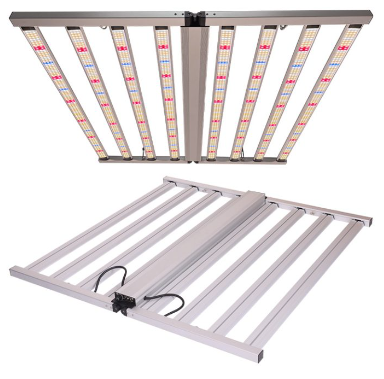As global demand for sustainable agriculture, urban vertical farming, and greenhouse horticulture continues to grow, the LED grow light industry has made significant technological advancements in recent years. Since 2018, the focus has shifted from merely improving performance to better adapting to diverse growing environments, optimizing light efficiency, and enhancing energy-saving features. In this article, we will explore the latest trends in the LED grow light industry, advancements in technical standards, and how to select the most suitable LED grow lights for your needs.
Development of Industry Standards
Back in 2018, there was a wide variety of LED grow lights available in the market, but the lack of detailed performance standards made it challenging for greenhouse growers and plant factory managers to choose the right lighting solutions. Organizations like the American Society of Agricultural and Biological Engineers (ASABE) released guidelines for measuring and testing LED grow lights for plant growth, while groups like the Japan Plant Factory Association proposed LED performance indicators to standardize testing.
By 2024, industry standards have further evolved, with more countries and regions developing unified technical specifications. For example, ASABE and the International Commission on Illumination (CIE) have collaborated to create global testing methodologies. This allows for easy comparison between different brands of LED grow lights across the world. These changes not only help farmers select the right lights more efficiently but also push manufacturers to improve product performance and increase transparency.
Technological Advancements in LED Grow Lights
In the past five years, LED grow light technology has seen several major breakthroughs, including improvements in light quality, energy efficiency, and customization:
Full-Spectrum Technology Adoption
By 2024, most LED grow lights now utilize full-spectrum designs that mimic the light spectrum of natural sunlight. Unlike earlier designs that focused mainly on red and blue light, full-spectrum LED grow lights support comprehensive plant growth, positively impacting photosynthesis and overall plant development. Full-spectrum technology is especially useful for all growth stages, from seedling to vegetative and flowering phases.
Higher Efficiency and Energy Savings
Modern high-end LED grow lights boast a photosynthetic photon efficacy (PPF Efficacy) of over 3.0 µmol/J, compared to 1.5-2.0 µmol/J in 2018. Higher PPF Efficacy means that lights can produce more photons with less energy, significantly reducing electricity costs and operational expenses. If you are looking for energy-efficient LED grow lights, these are among the most advanced options available on the market.
Smart Controls and Automation
With the rise of IoT technology, more LED grow lights now come equipped with built-in smart control systems. These systems can connect to sensors and adjust the light spectrum, intensity, and duration based on plant growth stages and environmental conditions, making plant cultivation more efficient and precise. Consider investing in smart LED grow lights that offer automation and remote control options to save time and improve plant health.
Modular and Customizable Designs
To cater to different growing environments, modular LED grow light designs have become mainstream by 2024. Users can configure their lighting setup based on the size of the growing area and the type of crops. This flexibility benefits both small home growers and large-scale plant factories looking for efficient solutions. Whether you need modular grow lights for your indoor garden or customizable grow light designs for large commercial setups, there is a solution to fit every growing space.
How to Choose the Right LED Grow Light
With so many options available, how do you select the right LED grow light for your needs? Here are some key factors to consider when making your decision:
Light Spectrum
Plants require different light spectrums at various growth stages, such as seedling, vegetative, and flowering phases. Full-spectrum LED grow lights are ideal for all growth stages, but you can also opt for lights with dimming capabilities that allow you to adjust the spectrum as needed. Adjustable LED grow lights can provide a tailored lighting solution depending on your crops’ needs.
Photosynthetic Photon Efficacy (PPF Efficacy)
The higher the PPF Efficacy, the more efficient the light is at promoting plant growth with minimal energy use. LED grow lights with a PPF Efficacy of over 2.5 µmol/J are considered highly efficient, while those exceeding 3.0 µmol/J represent top-of-the-line performance.
Heat Dissipation
The lifespan and stability of LED grow lights depend on their cooling systems. Proper heat dissipation helps prolong the life of the lights, reduces light degradation, and ensures stable operation even in high-temperature environments. Look for heat-efficient LED grow lights that ensure long-term durability.
Smart Control and Automation
If you are aiming for maximum efficiency, look for LED grow lights with smart control features. These allow you to remotely adjust the lighting conditions using a smartphone or computer and can integrate with environmental sensors for real-time adjustments, reducing manual intervention.
Protection Rating (IP Rating)
For greenhouse and outdoor growers, the water and dust resistance of grow lights is crucial. LED grow lights with an IP65 rating or higher offer excellent protection against moisture and dust, ensuring long-term reliability in harsh environments. IP-rated LED grow lights are essential for outdoor or greenhouse applications.
Future Outlook

These future advancements in AI-powered LED grow lights will allow for more precise plant care and even greater energy savings.
Conclusion
By 2024, the LED grow light market has entered a new phase of intelligence, efficiency, and standardization. For farmers, plant factory managers, and home gardeners, selecting the right LED grow lights has become easier than ever. Full-spectrum, high-efficiency, smart-controlled, and modular designs have emerged as the dominant features in the future of agricultural lighting.
If you’re planning to upgrade or purchase new LED grow lights, make sure to consider key factors such as light spectrum, PPF Efficacy, and heat dissipation to choose the most suitable product for your crops and growing environment.
Contact us today to learn more about the latest LED grow light technologies and get personalized cultivation solutions! Whether you need commercial grow lights, indoor LED lights, or energy-efficient grow lighting, we have the right products to help you succeed.































